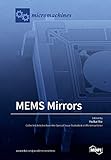MEMS Mirrors
Material type: ArticleLanguage: English Publication details: MDPI - Multidisciplinary Digital Publishing Institute 2018Description: 1 electronic resource (VI, 210 p.)ISBN:
ArticleLanguage: English Publication details: MDPI - Multidisciplinary Digital Publishing Institute 2018Description: 1 electronic resource (VI, 210 p.)ISBN: - 9783038428671
- 9783038428688
Open Access star Unrestricted online access
MEMS mirrors can steer, modulate and switch light, as well as control the wavefront for focusing or phase modulation. MEMS mirrors have found enormous commercial success in projectors, displays and fiberoptic communications. Micro-spectrometers based on MEMS mirrors are starting to appear in the consumer market. There are also many breakthroughs in applying MEMS mirrors for endoscopic imaging. Equally excitingly, a new wave of opportunities for MEMS mirrors is coming up, for example, micro-LiDAR for autonomous driving and robotics, optical cross connect (OXC) for cloud data centers, and optical scanners for virtual reality/augumented reality, just to name a few. Of course, there are a number of big challenges that researchers and engineers must overcome to fully utiltize MEMS mirrors’ potential: modeling and control are inherently complex due to the multiphysics, multi-DOF and nonlinear nature of the microactuators for MEMS mirrors; reliability is always a huge hurdle for commercilization; and the tradeoffs among the speed, aperture, and scan range are often overwhelming. Accordingly, this Special Issue seeks to showcase research papers, short communications, and review articles that focus on: (1) novel designs, fabrication, control, and modeling of MEMS mirrors based on all kinds of actuation mechanisms; and (2) new developments of applying MEMS mirrors of any kind in consumer electronics, optical communications, industry, medicine, agriculture, space, or defense.
Creative Commons https://creativecommons.org/licenses/by-nc-nd/4.0/ cc https://creativecommons.org/licenses/by-nc-nd/4.0/
English
There are no comments on this title.

